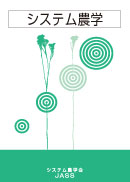巻号一覧

3 巻 (1987)
- 2 号 p. 54-
- 1 号 p. 48-
3 巻, 1 号
選択された号の論文の3件中1~3を表示しています
- |<
- <
- 1
- >
- >|
投稿論文
-
小林 達吉1987 年 3 巻 1 号 p. 48-63
発行日: 1987/05/01
公開日: 2024/02/05
ジャーナル オープンアクセスOil crisis以来のBiomassに関する世界的な研究活動により、農業に対する柔軟な考え方の必要が痛感される様になった。降雨量、温度等に恵まれている日本農業の活性化の一つは、農地面積の拡大と活用のノウハウである。国土の地形は、傾斜地面積が広く表1の様であるが、農業用地は14.5%に過ぎない。食料に関し、その輸入が人口1人当たり日本の2倍近い状況にあっても、加工品を含めてその輸出が多いため1人当たりの輸出入収支は英国の方が少ない。これらの点を明らかにし、地形の類似するイタリアの農業と農産物とその加工品の特色を調査し、傾斜地利用をイタリア並みに仮定すれば、なお1,000万haに近い傾斜地利用の可能性が考えられ、その長期的展望について所信を述べる。抄録全体を表示PDF形式でダウンロード (1187K) -
岸根 卓郎1987 年 3 巻 1 号 p. 64-76
発行日: 1987/05/01
公開日: 2024/02/05
ジャーナル オープンアクセス森林には経済機能と公益機能の二つの機能があるが、両機能は一般には二律背反の関係にあって両立しがたく、そのままでは両者の調和は困難である。なぜなら、森林の経済機能(木材生産機能)は森林の伐採によってのみ達成されるのに対し、公益機能(非木材生産機能としての土砂崩壊防止機能、水資源涵養機能、空気浄化機能、レクリェーション機能など)は森林の維持によってのみ達成されるからである。本稿においては、このように相反する森林の経済公益両機能の調和を人為的制御(森林政策)によって解決するための理論、より具体的には、森林を経済林と公益林に最適に利用するための「森林利用の最適計画論」を明らかにすることにある。私見では、そのための理論には二つの方向がある。第一は、いわゆる「限界効用均等の理論」に基づく方向であり、第二はいわゆる「選択の理論」に基づく方向である。本稿では、このうちの選択理論に基づく森林利用の最適計画論について述べる。選択理論の見地からの森林利用の最適計画論では、経済林対公益林の生産変換曲線と経済林対公益林の等効用曲線(効用無差別曲線)とが接する点で、全森林を経済林面積と公益林面積とに利用区分するのが森林利用の最適計画であるとする。ただし、それを証明するには、はじめに「経済林対公益林の生産変換曲線」と「経済林対公益林の等効用曲線」について明らかにしておく必要がある。抄録全体を表示PDF形式でダウンロード (724K) -
―三重県御浜町の農用地開発事業を通して―山本 太一1987 年 3 巻 1 号 p. 77-94
発行日: 1987/05/01
公開日: 2024/02/05
ジャーナル オープンアクセスThe achievement of the total system for reorganizing regional agriculture may be expected very much in the government policies for agriculture and rural community and its models are now studied hard by economists and sociologists in agriculture. Thus, when land and water resources development projects are recently conducted, at the same time, something like its models is commonly designed for reorganizing a regional agriculture composed of its agencies and farmers. Agencies usually include those of national and local governments, agricultural cooperatives, land and water use groups. etc., which must perform their own parts of a regional agriculture. The total system, to be noticed, works on two principles of “medium or intermediate” and “organism or interrelation” which are today highlighted by regionalists and agronomists respectively. “Medium” based on a regional ecology and community is meaned by all intermediates, such as, agencies of individuals supported by a totality but not a choice of decentralization or centralization, a medium technology between traditional and modern technologies. This paper will argue that the above position of the total system presents an overly optimistic view. It neglects two important aspects of both the expectations bias under the present changeable and unforeseeable circumstance, and the internal inequality (conflict) and the external inequality of regional agriculture reorganized by the total system. The writer's recent study, therefore. raises a serious question about that the total system might be taken no further notice of these policies in the future, just as the cooperative groups for joint farming have flickered out soon after these established extensively during 1960's-1970's; because of the internal conflict (antagonism) and the external conflict of these groups. The internal conflict is an uncompatibility or inequality with the satisfaction of members' objectives and the effectiveness of the institutional-organizational framework of the total system in developing regional agriculture, that is, antagonism between individuals and their groups. This conflict is caused by its own system of infrastructure and incentives which break down when the system is overthrown (oriented totalism or collaboration), and by members' self-organized system (oriented individualism). The external conflict is a deficiency of adapting a group or organization to its environment, that is, a shortage of its own self-reforming ability met by its external change. The inequality and the deficiency are found as two facts by researching a successful group (I Agric. Coop. Inc.) and a failed group (0 Agric. Coop. Inc.) for joint farming at middle and late season citrus varieties product area in Mihama district in Mie prefecture. The two facts will be by no means special factors of joint farming, but rather be concerned about points of preventing the total system from reorganizing regional agriculture. The method of finding the facts is a way to research the groups and to examine them by the system conceptions of “Modern Organization Theories”, such as, these of C. I. Barnard, H. A. Simon, J. G. March, and H. I. Ansoff.抄録全体を表示PDF形式でダウンロード (1559K)
- |<
- <
- 1
- >
- >|